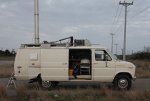|
The chipset detetmibe a what mode to operate under. It should I belive operate up to MCS7. The chipset /driver makes the decision about what mode to go into. In your case the noise floor is the limiting factor. the nodes have to push higher power (slower speed) to get over the noise. As speed picks up the tx power decreases (linearity of signal amplifier) so you can't expect full speed in your case because it would drop the signal into the noise floor. for modeling levels: personaly I model anywhere from -96 to -85 dbm and extrapolate based on what I know. Modeling is a bit of an art as much as if is a science you have to know when to doubt the data and when to trust the data. a -74 would be a generally safe number in many cases as that gives you plenty of room (~22db) for noise floor and for signal strength for a good strong signal but would likely be overkill for a true "I can connect and use it" model.
Ive seen some nodes flirting in the -86dbm range (noise floors in the -92ish). Are they my best links? No , do they connect and get the job done, yes, would I like better, of course. Conversely I got another couple nodes in the -74dm range with a -82dbm noise floor (yes it hurts ) and they have some fair amount of drop (30-50%) If I put some small dish antennas it will get better I just haven't done it yet.
So the -70's won't hurt to model in but know it's possible to do in the weaker zones. I tend to model using a low gain antenna (10dbi) due to my conservative nature and know I can make the link stronger if needed that is one reason I model closer to the -96 mark but I also know not to assume any link is guranteed to work.. |
